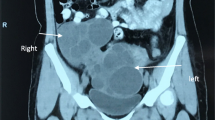Abstract
Purpose
To present a patient with familial partial lipodystrophy (FPLD) and polycystic ovary syndrome (PCOS) who was admitted with spontaneous ovarian hyperstimulation syndrome (OHSS)-like extremely enlarged ovaries, which was successfully treated using gonadotropin-releasing hormone analogs and abdominal cyst aspiration in combination.
Method
This is a descriptive case report of a single patient with FPLD and PCOS.
Results
Clinical improvement was achieved 6 months after therapy besides progressive reduction in total testosterone and DHEAS. Furthermore, there was a significant improvement in hyperinsulinemia and hypertriglyceridemia. Additionally, reduction in the size of ovarian cysts, reduction in the size and number of localizations of acanthosis nigricans, reduction in scores of mFGS, and weight loss were also observed.
Conclusion
Although there are few reports in the literature describing the association between PCOS with FPLD, management of this novel spontaneous OHSS-like condition has not yet been clearly defined. In the case of extremely enlarged multicystic ovaries and severe hyperandrogenemia, GnRH analogs may be considered to prevent ovarian enlargement and reduce hyperandrogenemia, especially when other treatment options are inappropriate.


Similar content being viewed by others
Data availability
The data that support the findings of this study are available on request from the corresponding author. The data are not publicly available due to privacy or ethical restrictions.
References
Brown RJ, Araujo-Vilar D, Cheung PT, Dunger D, Garg A, Jack M et al (2016) The diagnosis and management of lipodystrophy syndromes: a Multi-Society Practice Guideline. J Clin Endocrinol Metab 101(12):4500–4511. https://doi.org/10.1210/jc.2016-2466
Dunnigan MG, Cochrane MA, Kelly A, Scott JW (1974) Familial lipoatrophic diabetes with dominant transmission. New Syndr Q J Med 43(169):33–48
Garg A, Peshock RM, Fleckenstein JL (1999) Adipose tissue distribution pattern in patients with familial partial lipodystrophy (Dunnigan variety). J Clin Endocrinol Metab 84(1):170–174. https://doi.org/10.1210/jcem.84.1.5383
Boschmann M, Engeli S, Moro C, Luedtke A, Adams F, Gorzelniak K et al (2010) LMNA mutations, skeletal muscle lipid metabolism, and insulin resistance. J Clin Endocrinol Metab 95(4):1634–1643. https://doi.org/10.1210/jc.2009-1293
Garg A, Vinaitheerthan M, Weatherall PT, Bowcock AM (2001) Phenotypic heterogeneity in patients with familial partial lipodystrophy (dunnigan variety) related to the site of missense mutations in lamin a/c gene. J Clin Endocrinol Metab 86(1):59–65. https://doi.org/10.1210/jcem.86.1.7121
Diker-Cohen T, Cochran E, Gorden P, Brown RJ (2015) Partial and generalized lipodystrophy: comparison of baseline characteristics and response to metreleptin. J Clin Endocrinol Metab 100(5):1802–1810. https://doi.org/10.1210/jc.2014-4491
Hegele RA, Cao H, Anderson CM, Hramiak IM (2000) Heterogeneity of nuclear lamin A mutations in Dunnigan-type familial partial lipodystrophy. J Clin Endocrinol Metab 85(9):3431–3435. https://doi.org/10.1210/jcem.85.9.6822
Monajemi H, Stroes E, Hegele RA, Fliers E (2007) Inherited lipodystrophies and the metabolic syndrome. Clin Endocrinol 67(4):479–484. https://doi.org/10.1111/j.1365-2265.2007.02906.x
Decaudain A, Vantyghem MC, Guerci B, Hecart AC, Auclair M, Reznik Y et al (2007) New metabolic phenotypes in laminopathies: LMNA mutations in patients with severe metabolic syndrome. J Clin Endocrinol Metab 92(12):4835–4844. https://doi.org/10.1210/jc.2007-0654
Vantyghem MC, Vincent-Desplanques D, Defrance-Faivre F, Capeau J, Fermon C, Valat AS et al (2008) Fertility and obstetrical complications in women with LMNA-related familial partial lipodystrophy. J Clin Endocrinol Metab 93(6):2223–2229. https://doi.org/10.1210/jc.2007-2521
Sun B, Ma Y, Li L, Hu L, Wang F, Zhang Y et al (2020) Factors Associated with ovarian hyperstimulation syndrome (OHSS) Severity in women with polycystic ovary syndrome undergoing IVF/ICSI. Front Endocrinol 11:615957. https://doi.org/10.3389/fendo.2020.615957
Huang-Doran I, Kinzer AB, Jimenez-Linan M, Thackray K, Harris J, Adams CL et al (2021) Ovarian hyperandrogenism and response to gonadotropin-releasing hormone analogues in primary severe insulin resistance. J Clin Endocrinol Metab 106(8):2367–2383. https://doi.org/10.1210/clinem/dgab275
Palomba S, Falbo A, Zullo F, Orio F Jr (2009) Evidence-based and potential benefits of metformin in the polycystic ovary syndrome: a comprehensive review. Endocr Rev 30(1):1–50. https://doi.org/10.1210/er.2008-0030
Brown RJ, Joseph J, Cochran E, Gewert C, Semple R, Gorden P (2017) Type B Insulin resistance masquerading as ovarian hyperthecosis. J Clin Endocrinol Metab 102(6):1789–1791. https://doi.org/10.1210/jc.2016-3674
Lewandowski KC, Lewinski A, Dabrowska K, Jakubowski L, Gach A (2015) Familial partial lipodystrophy as differential diagnosis of polycystic ovary syndrome. Endokrynol Pol 66(6):550–554. https://doi.org/10.5603/EP.2015.0067
Joy TR, Hegele RA (2008) Prevalence of reproductive abnormalities among women with familial partial lipodystrophy. Endocr Pract 14(9):1126–1132. https://doi.org/10.4158/EP.14.9.1126
Gambineri A, Semple RK, Forlani G, Genghini S, Grassi I, Hyden CS et al (2008) Monogenic polycystic ovary syndrome due to a mutation in the lamin A/C gene is sensitive to thiazolidinediones but not to metformin. Eur J Endocrinol 159(3):347–353. https://doi.org/10.1530/EJE-08-0272
Author information
Authors and Affiliations
Contributions
All authors contributed to the study’s conception and design. The first draft of the manuscript was written by Asena Gökçay Canpolat and all authors commented on previous versions of the manuscript. All authors read and approved the final manuscript.
Corresponding author
Ethics declarations
Informed consent
The patient (B.V), gave written consent for the use of her personal medical records for the writing of this article.
Competing interests
The authors declare no competing interests.
Additional information
Publisher's note
Springer Nature remains neutral with regard to jurisdictional claims in published maps and institutional affiliations.
Supplementary Information
Below is the link to the electronic supplementary material.
Supplementary file1 (MP4 1399 KB)
Rights and permissions
Springer Nature or its licensor (e.g. a society or other partner) holds exclusive rights to this article under a publishing agreement with the author(s) or other rightsholder(s); author self-archiving of the accepted manuscript version of this article is solely governed by the terms of such publishing agreement and applicable law.
About this article
Cite this article
Gökçay Canpolat, A., Aslan, B. & Şükür, Y.E. A promising treatment for spontaneous ovarian hyperstimulation syndrome due to familial partial lipodystrophy: GnRH analogs combined with cyst aspiration. Hormones 22, 741–745 (2023). https://doi.org/10.1007/s42000-023-00469-z
Received:
Accepted:
Published:
Issue Date:
DOI: https://doi.org/10.1007/s42000-023-00469-z




